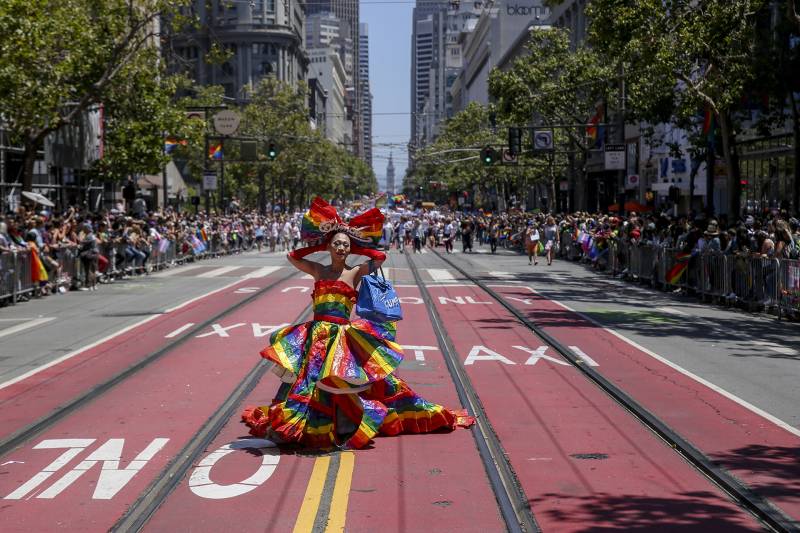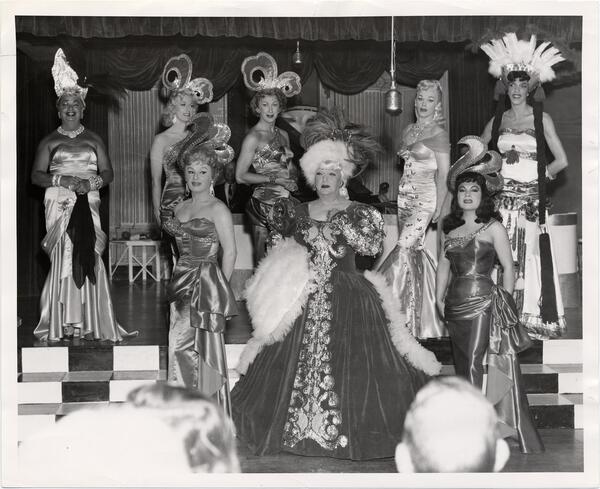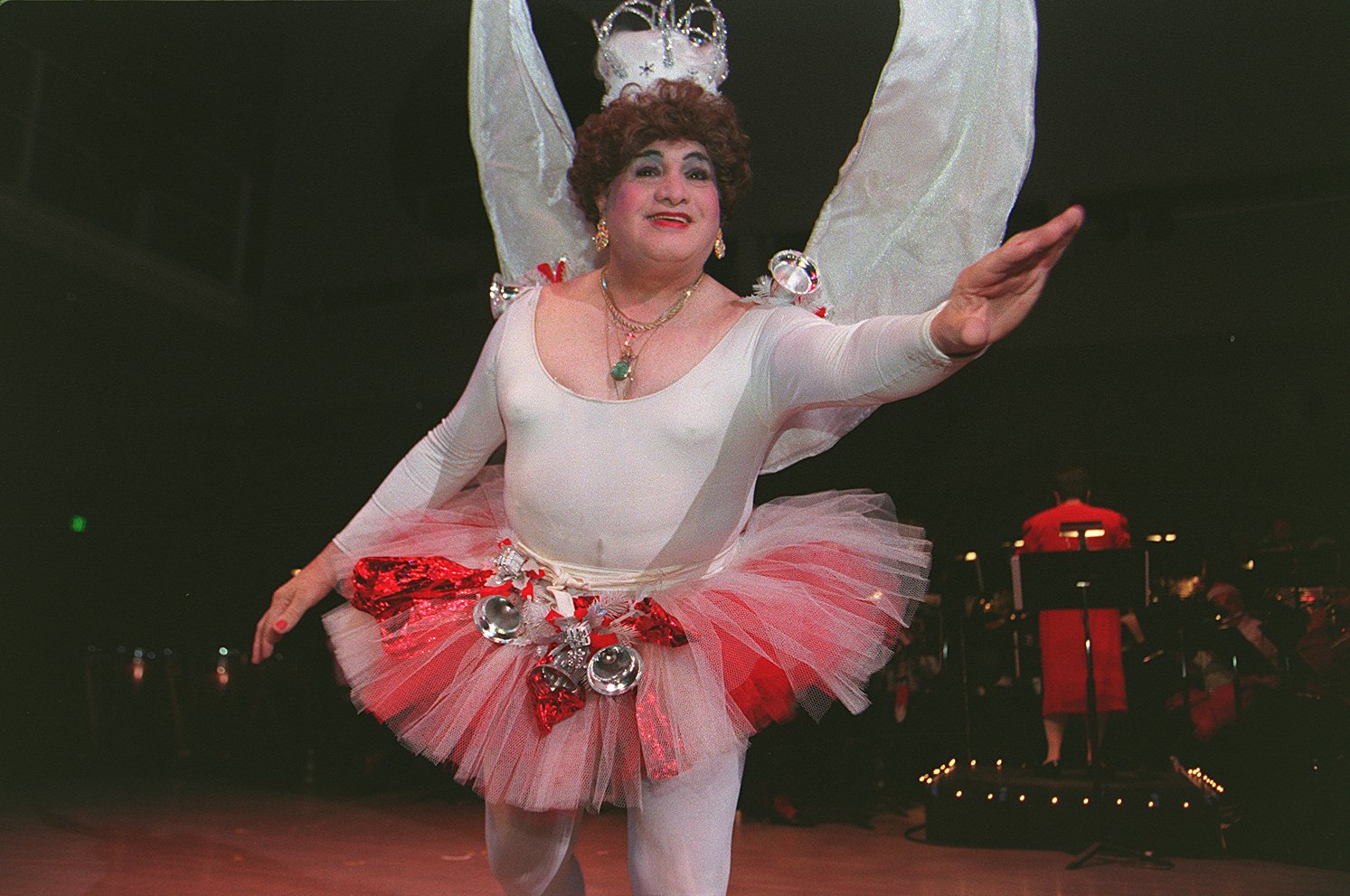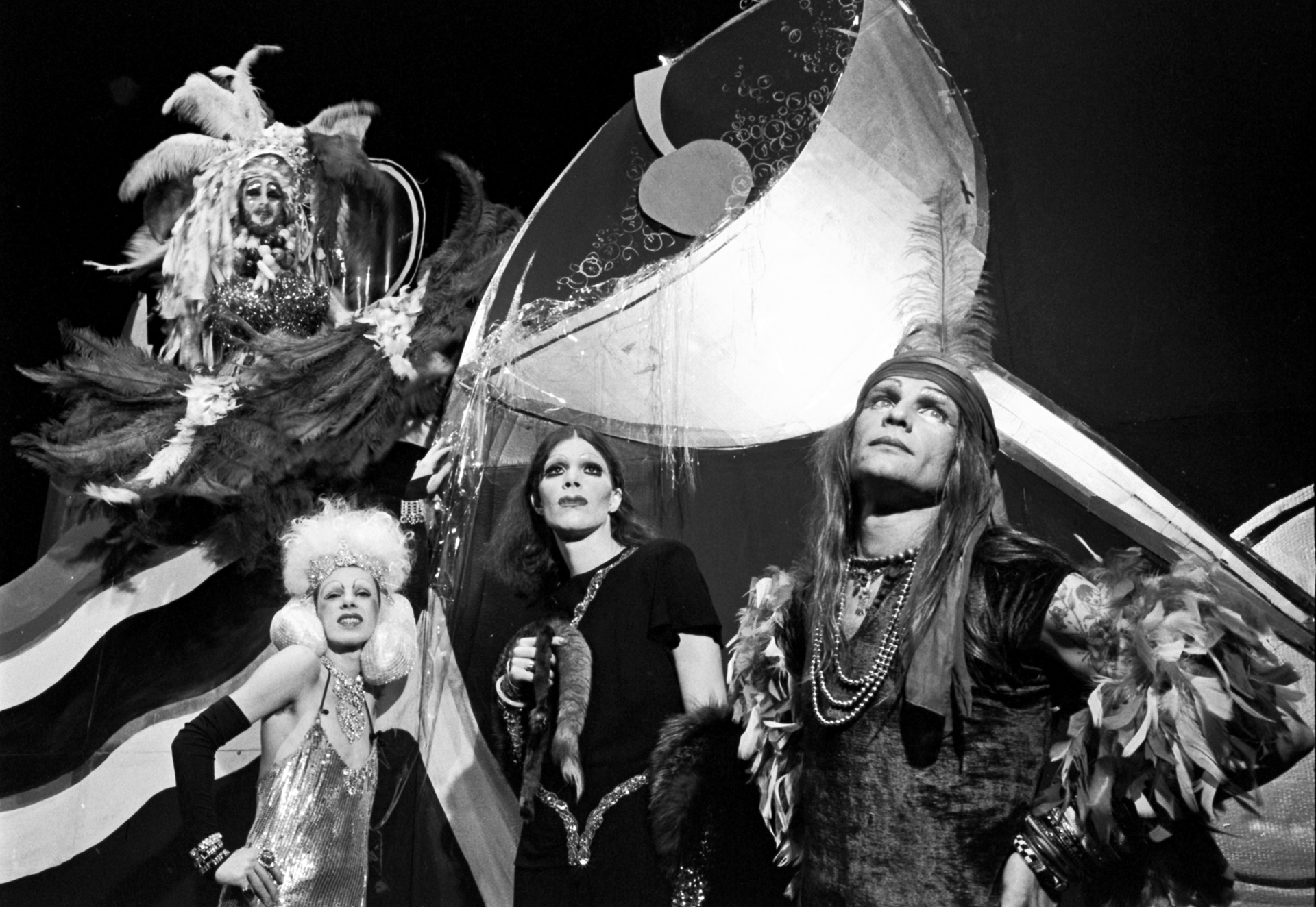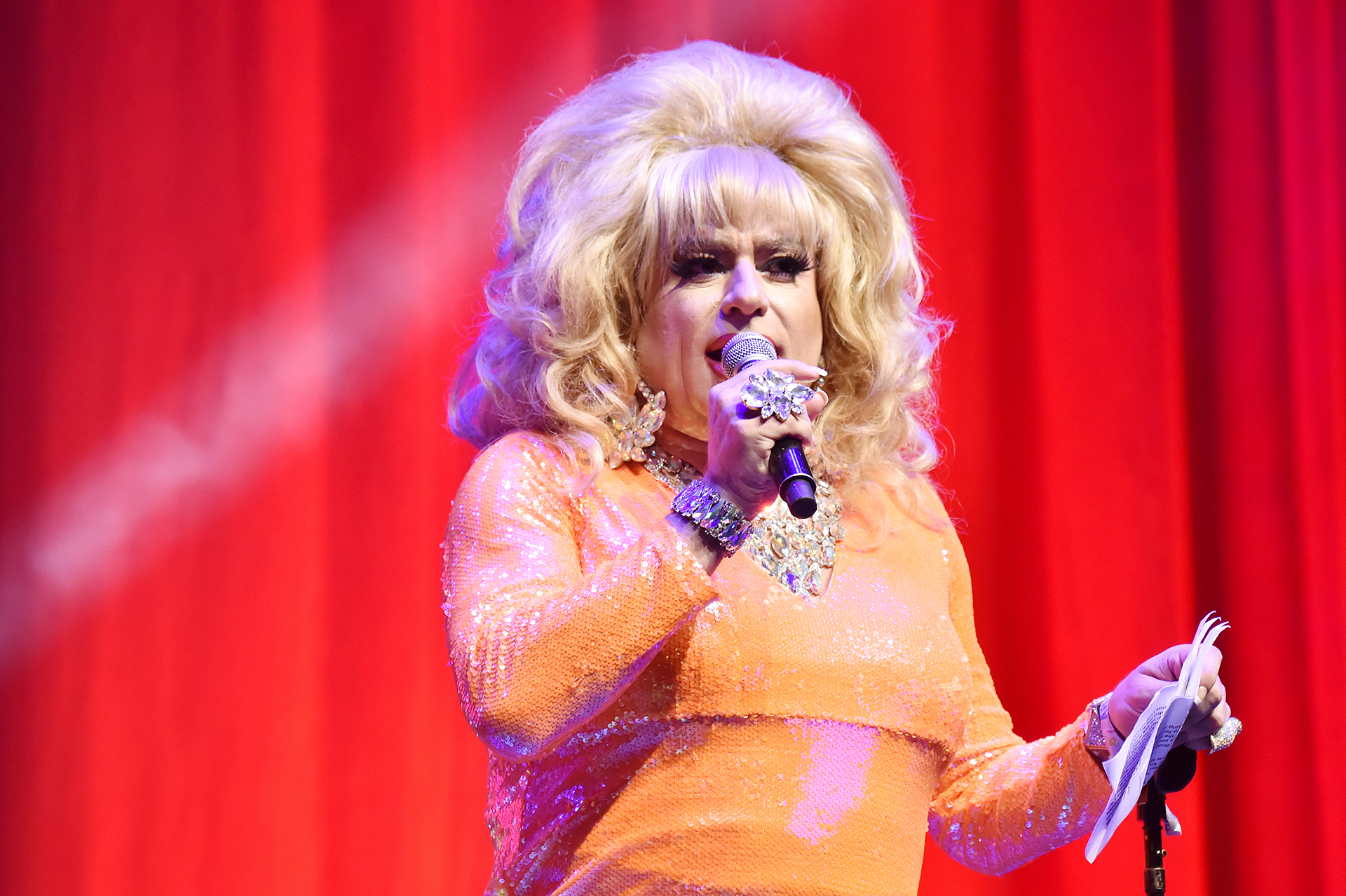Episode Transcript
Olivia Allen-Price: In the past decade, drag has become a centerpiece of American pop culture.
[Start Ru Paul’s Drag Race theme music]
Olivia Allen-Price: Maybe you’ve seen RuPaul’s Drag Race on MTV. The show and its host have won armfuls of Emmy awards. And RuPaul is widely regarded as the most famous drag queen in the world.
RuPaul’s Drag Race clip: The time has come for you to lip sync for your LIFE!
Olivia Allen-Price: Then there’s the drag brunches, drag bingo — and more recently, the Drag Story Hour — that have become ubiquitous in many cities.
But growing attention has also led to growing disdain.
News clip: It has everything to do with this being inappropriate.
Olivia Allen-Price: Whether it’s love or hate on the national stage, drag is a hot topic of conversation. And you really can’t understand how we got to this point nationally without heading to San Francisco.
Peaches Christ: Drag in San Francisco is as crucial to the identity of this city as the cable car.
Olivia Allen-Price: We thought it was high-heel time to take a closer look at drag culture in San Francisco. Today, we’re taking a crash course through decades of Drag Herstory to better understand its larger impact on San Francisco and the country.
Peaches Christ: Straight people have wigs in this town.
Olivia-Allen Price: A note: There is some potentially offensive language in this episode.
I’m Olivia Allen-Price. Stick around for Bay Curious.
[Sponsor Message]
Olivia Allen-Price: On any given night in San Francisco you can step into any number of bars in the city and find a drag queen at the center of the action. Like Betty Fresas at Midnight Sun on Thursday nights. She cracks jokes, lip-syncs, celebrates birthdays with shots … and light humiliation. It’s a blast!
But in San Francisco, our queens do so much more than entertaining bar patrons. They serve their communities through fundraising, political activism and even by holding public office.
KQED’s Christopher Beale spoke with three of San Francisco’s drag icons, starting with Peaches Christ.
Christopher Beale: What is a drag queen?
Peaches Christ: A drag queen is someone who likes to use fabulous costumes and exaggerated performance to entertain people. And a drag queen, traditionally, has meant a cis man who dons women’s clothes for entertainment purposes, usually pretty fabulous and flamboyant.
Christopher Beale: There are examples of what we might call drag today dating back centuries. The first time it was actually called, that is believed to have happened around 1870. In the time since drag queens have evolved from underground entertainment to queer community leaders to international megastars.
Peaches Christ: We’re kind of queer preachers in a way. We create fellowship, we create community, we make people laugh, we make people feel good about themselves, and when the shit hits the fan and stuff needs to be done, you often see it’s drag queens who are community organizers and the ones mobilizing to take care of a need.
Christopher Beale: In San Francisco, drag dates back to at least the 1930s, but this isn’t a comprehensive history. The scene is too vibrant, and it could take hours — and many, many costume changes — so what I want to do is hit on a few key moments when drag culture left big impacts on San Francisco.
Peaches Christ: Early drag in San Francisco, it was an art form that actually wasn’t seen as that queer because they sort of presented it in a way that was safe for straight audiences.
Christopher Beale: Remember the opening scene of the Robin Williams movie The Birdcage? Think of a straight nightclub featuring female illusion.
Peaches Christ: In San Francisco, the longest-running nightclub that featured drag was called Finocchio’s over in North Beach. And it was around for decades
Christopher Beale: From the mid-30s to the late 90s, these clubs in North Beach would feature drag queens lip-syncing pop songs and making jokes for largely straight audiences. This was light-hearted fun. None of the heavy stuff, and definitely no politics. But that was about to shift.
Peaches Christ: And when that shift happened is when San Francisco really became different, and sort of special and unlike other drag communities.
Christopher Beale: This drag queen named Jose Sarria started making noise about gay rights from the stage at another North Beach hotspot called, The Black Cat Club, encouraging people to stop living double lives.
Sarria would grow his influence and go on to become the first openly gay candidate for public office in the United States in 1961, when he ran for a board of supervisor’s seat. He didn’t win, but he did reveal the power of the gay voting bloc in San Francisco and helped forge a path for Harvey Milk to be elected almost 20 years later.
Jose Sarria didn’t take the electoral loss lying down, he continued his community work in drag and went on to inspire the creation of the Imperial Court system, an international network of charities still in operation today.
Christopher Beale: A few years later, in 1966, drag performers were part of a pivotal moment in San Francisco and LGBTQ history. The night the Tenderloin became a tinder box of activity.
Peaches Christ: Compton’s Cafeteria was a late-night dining spot.
Christopher Beale: A clean, safe, well-lit 24-hour diner in the Tenderloin.
Peaches Christ: Trans folks, drag performers, sex workers, the community could go there, this was a known place for people to gather.
Christopher Beale: “Female impersonation” was still a crime in the 60s and the police regularly harassed people outside the gender binary. Even in the relative safety of the Tenderloin, which was then seen as a gay neighborhood, queer people were never truly safe. And on one hot August night, workers at the cafeteria called the police to deal with what they deemed rambunctious diners. Police records from the time don’t exist anymore, but a police officer is said to have grabbed a trans woman to arrest her.
Peaches Christ: And the community fought back.
Christopher Beale: She responded by throwing a cup of coffee in his face.
Peaches Christ: It broke out into a rebellion that took to the streets.
Christopher Beale: Sugar shakers were thrown through the restaurant windows and drag queens were seen beating police with heavy purses. A newsstand on the corner was set on fire.
Christopher Beale: The Compton’s Cafeteria riot didn’t lead to the changes that Stonewall would a few years later, but it stands as the first known example of collective militant queer resistance to police harassment in U.S. history.
Peaches Christ: It is worth noting that these trailblazers existed and that they were real heroes and really brave and they were trans women and drag performers who were fighting police on the streets of the Tenderloin.
[Start 1960s era music]
Christopher Beale: Drag expression was undergoing a huge change during this era as well. In the late 1960s, The Cockettes burst onto the scene. They were as counter-culture as you could get and were some of the first to break the traditional “cis man dressed as a woman” mold for drag.
Peaches Christ: I guess you could say they were hippies; they would put glitter in their beards, and they lived together like a commune. They were an inclusive drag troupe that included straight people, cis women, men, trans women…
Christopher Beale: The Cockettes became notorious for these wild midnight movies at the Palace Theater in North Beach, where drag performers would sing and dance in the aisles during films from greats like John Waters.
Peaches Christ: They were fueled by glitter and drugs and lots and lots of talent.
[start “Mighty Real” by Sylvester]
Christopher Beale: Divine — the controversial and influential drag queen from some of those John Waters movies — has performed with the Cockettes, and at one point, San Francisco recording artist and LGBTQ pioneer Sylvester was a Cockette.
[End music]
Christopher Beale: The Cockettes became so popular, so fast, that the group began to splinter into cliques and eventually fell apart, though some members still perform today.
The Cockettes over the top, irreverent, no-holds-barred style of drag would help inspire generations of queens to push the envelope.
[Somber music starts]
Sister Roma: Around 1982, HIV AIDS started to ravage the community.
Christopher Beale: That is philanthropist, drag queen and member of the Sisters of Perpetual Indulgence, Sister Roma.
Sister Roma: It was scary. Nobody knew what it was. All people knew is that gay men, mostly, were getting sick and dying. I remember checking my tongue for white spots and feeling my lymph nodes. It was like AIDS hysteria.
Christopher Beale: Americans began seeing TV reports like this one demonizing the LGBTQ community.
Archival Tape: …The lifestyle of some male homosexuals has triggered an epidemic and a rare form of cancer.
Christopher Beale: In 1987, Roma was looking for a way to help when she discovered and quickly joined this fairly new ragtag order of drag queen nuns called the Sisters of Perpetual Indulgence.
They’d been founded on Easter Sunday in 1979.
Two of those early sisters were medical professionals, and as soon as HIV and AIDS was discovered to be sexually transmitted, the Sisters sprang into action.
Sister Roma: We went out almost every night, went through all the bars, getting condoms into hands, getting condoms into people’s minds, into their forefront. Because we wanted to protect people and to save lives.
Christopher Beale: They created the first safer sex pamphlet known to feature sex-positive language, practical advice, and most importantly, humor. When they weren’t doing safer sex outreach in the clubs, the Sisters were…if you’ll pardon the pun…raising hell in the streets.
Sister Roma: Raising picket signs and bullhorns just to get people to even acknowledge that we were dying, that we needed help. Because there was a real consensus among some people that HIV AIDS wasn’t an issue because it was killing all the right people. It was intravenous drug users, prostitutes, and faggots. Who cares, right?
Christopher Beale: There was a time when about a third of San Francisco’s 60,000+ gay men were dying of AIDS, and the Sisters became beacons of hope for the community.
As AIDS became less prevalent, the Sisters ranks continued to fill with people who wanted to give back, and the Sisters have continued to grow in influence and visibility.
Sister Roma: Today we’re talking about a worldwide organization with probably a thousand members.
Christopher Beale: Easter in the Park with the Sisters of Perpetual Indulgence is an annual tradition that attracts thousands from all over to Dolores Park. It’s a big, boisterous celebration that’s become quintessentially San Franciscan.
[Music transition]
Christopher Beale: In the mid-90s, after the horror of AIDS began to wane, the LGBTQ+ community in San Francisco galvanized and began to go out like never before. Bars, clubs, and parties were packed as the community collectively blew off steam. In 1996, a drag queen named Heklina started a legendary SoMa party that put the spotlight on San Francisco’s unique blend of drag.
Heklina performance clip: Many stars have been born on this stage. This very very special stage. I would kiss this stage right now if it wasn’t covered with blood and shit.
Peaches Christ: Heklina in many ways was the truest embodiment of Punk rock to drag,
Christopher Beale: Heklina’s show was called Tranny Shack.
Peaches Christ: She created it. And proceeded to produce a different show every week at midnight, on a Tuesday, with packed houses for 13 years.
Heklina performance clip: I have wigs older than you are.
Christopher Beale: Back when the show was launched, Heklina chose the word “tranny” with an eye toward inclusivity. It was a slur, yes, but like a lot of slurs, it came to be reclaimed/adopted by the group it aimed to harm.
Peaches Christ: An irreverent and endearing way to refer to people who fell outside of the gender norm. Tranny back then referred to drag queens. Trans people. Transvestites, cross-dressers. And it referred to every little nuance in between because between all those things, there’s a lot of gray area, and between those things, there’s overlap.
Peaches Christ: And what Tranny Shack was, was a place where all these people could go, and did go, and be accepted and party and to have fun and it was wild. It was artistic. It was crazy. It was outrageous. It was drug and alcohol-fueled, and it was pure.
Christopher Beale: Over the next two decades, Peaches saw Heklina become a community leader, always helping to raise money for causes big and small, which was sort of the opposite of her on-stage persona.
Peaches Christ: She presented herself in many ways as an unapologetically greedy bitch.
Christopher Beale: But that was just a persona, Heklina loved to help people.
Peaches Christ: She was uncomfortable getting the credit for it.
Christopher Beale: When Heklina suddenly passed away in 2023, the city’s queer community came out by the thousands as if to honor a fallen hero.
Clip from Heklina’s funeral: So the event is simply, Heklina a memories. She would have hated this. Yes, yes, she would.
Peaches Christ: The reason thousands of people showed up for her memorial… it wasn’t just because she was a funny entertainer. Yes, that’s true. But people showed up in San Francisco because she had created community for them. She was a secret nice person.
[Music starts]
Per Sia: Drag is not just about entertainment. Drag is also community work.
Christopher Beale: Next, I want to introduce you to a not-so-secret nice person.
Per Sia: Persia or Persia. Either one works. Trust me. I’ve been called way worse.
Christopher Beale: A few years back Persia was performing in drag at night, but during the day…
Per Sia: I was working at a children’s afterschool arts program here in San Francisco, so I was leading a double life.
Christopher Beale: She was approached by a group planning to organize Drag Story Hour…where a drag queen reads a book to kids. The idea is representation, for children to have glamorous, positive, and queer role models and to feel free to play with their own gender expression. This was a new concept, but it hit Per Sia in the heartstrings. So, in December 2015…
Per Sia: Drag Story Hour started here in San Francisco. And I was the first performer to be part of that.
Christopher Beale: This was sort of a meeting of two worlds for Persia.
Per Sia: I was really nervous because up until that point, I kept everything separate.
Christopher Beale: But she got up in front of a room of kids, and she read to them.
Per Sia reading to kids: Again, my name is Per Sia. And I’m a drag queen. Welcome to Drag Story Hour.
Per Sia: I just remember just being so, so nervous. I had students of mine with their families come in. And at that moment, everything really hit. I was merging my lives together,
Christopher Beale in scene: Do you remember what book you read?
Per Sia: I read something unicorn. And then. A bear book. I don’t know.
Christopher Beale in scene: Unicorns and bears. That’s the takeaway.
Per Sia: Ha ha ha. Gay.
Per Sia: Afterwards, there was this feeling of calmness. And I had never experienced so much joy. And I’m not going to cry, but it was feeling like all my identities are in one place. And that’s how it felt when I left. And I was just like, oh, like. It’s like, damn I did that.
Little kids have the vocabulary to really identify what’s really going on inside, and that is so special to me.
And to know that now there’s 20-something chapters around the world, and that I was the first one, and that it started here in San Francisco. I’m just over the moon to just think that I am part of that history.
Christopher Beale: Drag Story Hour has received quite a bit of press attention, and conservative groups have targeted them, even showing up at places where queens are reading to children.
Christopher Beale in scene: Does that make you afraid when you go to these libraries or schools?
Per Sia: Yes. But I still push forward. Because I love what I do and if I don’t do that, then what am I going to do? I am already depressed, and anxiety is off the roof. Like, and if I don’t do what I like, then. I’m just going to go back in that hole, you know.
[Music starts]
Christopher Beale: Peaches Christ says the hate drag performers have received is simply a response to progress.
Peaches Christ: We as a community, have existed for many years behind closed doors, performing at night in nightclubs for queer people. We’ve progressed to the point where these families and these people that are so fear-based don’t like seeing us on their televisions. They don’t like seeing us on their kids’ computers or on their social media. They don’t want us in their libraries. They don’t want us in their schools. They don’t want us at their symphony halls. They don’t want us at their baseball stadiums.
Sister Roma: It’s important to realize that this is just the tip of the iceberg.
Christopher Beale: Sister Roma again.
Sister Roma: You can’t take away pride flags and you can’t say don’t say gay. Like we have always been here. Trans people, queer people have always, always been here. And we will always. Always be here. They don’t know who they’re picking a fight with. We have overcome much bigger battles we fought a plague. We showed the world how to, who react with compassion in the face of pandemic that was killing our community, we rose up and showed the world how to respond. We got this.
Christopher Beale: To people like Per Sia, Sister Roma, and Peaches Christ, San Francisco history and drag HERstory are inseparably intertwined. It’s hard to imagine The City without drag queens.
Peaches Christ: It’d be like taking the city and turning it black and white. San Francisco is full of color and fabulousness and by removing drag from it and all of its variations, I think you’d really mute what makes it special. This city is run by drag. It’s a drag oasis.
Almost 100 years have gone by since those first queens graced the stage in San Francisco. The city – and the world! – have been shaped by those that came after.
Sister Roma: We have a transgender cultural district, a leather cultural district, the Castro cultural district. We have a drag laureate, Darcy Drollinger. So many great queer trans drag leaders and so much to be proud of here in San Francisco. And this does remain a beacon of hope to our queer community worldwide.
That was Bay Curious reporter and sound engineer Christopher Beale.
Per Sia: GAY! *laugh & fade*
Olivia Allen-Price: At the end of every Bay Curious episode, you may have noticed we always say …
Voice over: Bay Curious is made in San Francisco at member-supported KQED.
Olivia Allen-Price: To us, member-supported is the operative phrase there. We are so proud that Bay Curious is available for free to everyone, but it does cost money to make.
Sixty percent of our budget comes from listeners. Many give $5, $10, $20 a month … and it adds up! If you’ve thought in the past, “Oh gosh, I really should donate” but haven’t gotten around to it (I’ve been there). This is your sign to make good on those thoughts. Don’t delay. Grab your phone and navigate to donate.kqed.org/podcasts … within minutes you’ll be done and feeling good about supporting shows like Bay Curious. Thanks!
Bay Curious is made in San Francisco at member-supported KQED. Our show is produced by Katrina Schwartz, Christopher Beale, and me, Olivia-Allen Price. Additional support from Jen Chien, Katie Sprenger, Cesar Saldana, Maha Sanad, Holly Kernan and the whole KQED Family.
